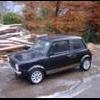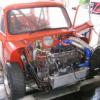i am superchargeing my 1380 over the summer.
i am trying to determine the size of the pulley for my 1380 and also my dads 998 which he is also supercharging.
i have a eaton m45 perfomance map from the web which has flow rate in m^3/hour plotted against pressure.
I need to calculate the flow rate the engine requires at different engine speeds, this bit is easy, just swept volume mulitplied by the number of inlet strokes... This gives theoretical volume induced but i need to know actual volume induced. There are obviously losses during the iduction stroke.
On a n/a engine this can be calculated by volumetric efficieny which is about 85%. However i need to work out volumetric efficiency for a forced induction engine. I have read on the internet that volumetric efficiency can go over 100% for a forced induction engine. I can't see how this is possible as in my view the volume of the cylinder is fixed so the induced volume cannot go above 100%. This gets me thinking it is mass flow or volume the air fuel would take up if it were at atmospheric pressure.
i hope i havn't lost you so what i have come up with is the expression below, can anyone confirm it is correct.
volumetric eff. = V1(volume of fuel/air mixture if at atmospheric pressur) / swept volume.
this leads to another question, the values on the performance map for flow rate (m^3/hour) - are these flow rate at say 7 psi or if the fuel air mixture is at atmospheric pressure.
i hope this all makes sense, anyone who can shed some light on this would be very usefull
















